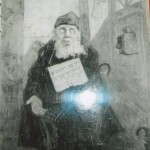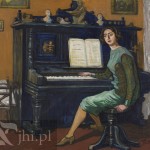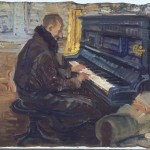Two things about this post today. First, an excerpt from Surviving Hitler in Poland: One Jew’s Story, a memoir written by Moshe Rynecki’s son, George. These three paragraphs are from a chapter titled, “My Father was a Painter.” Second, below is a photograph of a Moshe Rynecki painting held by the Jewish Historical Institute (ZIH) in Warsaw. I saw this photograph for the first time last week when the museum emailed me photos of 17 of the 52 Rynecki pieces held in their collection. I wonder if this piece might have been painted inside his home at 24 Krucza Street in Warsaw. The painting was acquired by ZIH in 1946. The painting is dated 1934. ZIH has[Read more…]
Street Musicians, 1932
Another of the 17 photos I received from the Jewish Historical Institute (ZIH) in Warsaw of my great-grandfather’s paintings. This one was obtained by the museum in 1946. I wish I knew where all the pieces that were obtained in 1946 were found. Did the person with whom Moshe hid the pieces hand them over or were they discovered in an abandoned home/barn/basement? Wish I knew…
This piece has been titled “Uliczni muzykanci” which translates to, I believe, The street musicians. It is dated 1932. The small children [Read more…]
Lost Art, Lost Stories
My goal continues to be to find more of my great-grandfather’s lost and missing paintings and to ask those who have his work to share those pieces and the stories behind the paintings with my family before that history is lost forever. Cultural artifacts are best understood within the history from which they arise. At its most basic level, the provenance of a painting is information about who painted it, who has owned it, and how each owner obtained it. But to truly understand a painting, one must know something of the [Read more…]
Moshe Rynecki piece at ZIH – Reminiscent of Chagall?
When I began searching for my great-grandfather’s lost work, I knew of only the pieces held by my family. It was from these pieces that I came to know and understand his body of work, his mode of expression, and a community he loved. Although my family has lamented the loss of the larger and once complete oeuvre, each piece is important in and of itself because it tells a story; a fleeting moment through which we can peer into the past. But as I continue to search, and find (!), lost and missing pieces I learn more and gain greater insight into his body of work. Each painting is a fragment of a larger story, and as I slowly recover images of his works held by others, a larger picture begins to reveal itself.
Today, the 2nd of the 17 photographs I received from the Jewish Historical Institute, in Warsaw, of works by my great-grandfather in their possession. (Please know that they have a total of 52 of his pieces.)
I’m fascinated by this piece. It seems so very unlike the style of his that I know so well and looks so very much like he’s trying out the flair of another artist. To me it is reminiscent of a Chagall. I find that so interesting because the piece is dated 1932, a time not so very early in his career. I’ve never seen another piece of his quite like this.
Notes from ZIH: akwarela/karton. Dwaj Zydzi na ulicy malego miasteczka [Two Jews on the street a small town] 1932
Two different #mrynecki paintings – both subjects at the piano
My favorite kind of posts to write are the ones where I get to share information about my great-grandfather’s paintings that are, to me, finds. Yesterday, I received an email from the Jewish Historical Institute (ZIH) in Warsaw. Their email contained photos of 17 (!!) Moshe Rynecki paintings that I had never (EVER!) seen before. It’s hard to describe what it’s like to see one of my great-grandfather’s paintings for the first time. The joy, the excitement, the thrill…it’s all part of my experience. This painting particularly grabbed me. I immediately recognized the piano and the stool – they appear in a painting in my family’s possession. But the woman, who is the woman? Is it Moshe’s wife, Perla? Is it his daughter, Bronislawa? He paints her so clearly – in a style and manner as if it really is someone he knows well and is close to him. I find the painting absolutely stunning and mesmerizing. Stay tuned, I will continue to share the other 16 photos over the coming days.
On the left: Acquired by ZIH in 1946. Inventory # A-781. “Mloda kobieta przy pianinie” [A young woman at the piano] dated 1926
Painting at right: Pianist. Held by the Rynecki family. undated.
Paintings Held by ZIH
In the spring of 2013 I was given an Excel spreadsheet detailing the holdings of Moshe Rynecki work at the Emanuel Ringelbaum Jewish Historical Institute (Żydowski Instytut Historyczny) in Warsaw, Poland. I would like to be clear that this spreadsheet was given to me by a Fulbright Scholar who was studying in Warsaw and who managed to get ZIH to give him this information. I have been asking ZIH for years for information about their holdings of my great-grandfather’s works. I have requested pictures and information in regards to the provenance of the Rynecki paintings they hold and really have yet to receive an official reply from the museum except for an email from a former curator who informed me the museum held 52 of his works. When this spreadsheet arrived in my email, it only had dates and words. I want to emphasize: it contained no images. Over the last several years I have managed to find photographs of a number of my great-grandfather’s paintings from a variety of sources (e.g., exhibition catalogs, books, articles, Polish auction websites, Polish stock photography sites, etc.). I have put together this document below using the ZIH inventory number along with the description (ZIH wrote it in Polish, I’ve used Google Translate to put it into English), and the dates appearing on the paintings. There are several pieces about which I am unsure if I have made a correct match. I have indicated these with the word “unsure.” As for a number break down, it is this: There are 52 pieces listed in this spreadsheet. I have photographs (if they are correctly matched) of 34 of these pieces. There are 18 pieces for which I have no photograph.
**Note: On 18 November I received digital photographs of 17 of the Moshe Rynecki works for which I had no image from ZIH. This means I am now only short the photograph of just a single piece. I am trying to determine which piece I still need. I am presently writing on a new blog to show all 17 images **
[This paragraph existed in the blog written 12 November 2013. I am leaving it here, but with the understanding that I now have 17 of the images I was previously missing: Given the recent success of petitioning the German government to be transparent about the information they have in regards to the Gurlitt collection of art recovered in Munich, I am hoping that my own pleas will be heard in Poland. Dear Jewish Historical Institute – You hold my great-grandfather’s paintings in your possession. They are part of on original collection of 800+ works. You cannot hold these paintings hostage and hidden from the world. You must share them – for the sake of history, because it’s the right thing to do, so that scholars may learn more about his body of work, and so that my family may know what else you’ve got. These paintings that you hold are not yours alone. They belong to a story larger than you. I call upon you, I plea with you, please let me see all the work and information that you hold about my great-grandfather.]
Note about the chart:
ACQ = Date ZIH acquired the piece
# = ZIH inventory number
subject = translation of Polish description of painting
Dated = Date on painting
DO NOT HAVE = [19 November 2013: Elizabeth Rynecki now has photographs of 17 of these images and is preparing a new blog with this information.]
| ACQ. | # | subject | Dated | |
| 1946 | A-110 | Blacksmith Jews by the fire |  (unsure) (unsure) |
|
| 1946 | A-188 | A blind beggar at synagogue | 1936 |  |
| A-189 | Jewish musicians | 1936 | [Read more…] |
Rynecki and Vishniac on the Jews of Poland
I’ve frequently been asked, “Were Roman Vishniac and Moshe Rynecki aware of each other’s work?” I really have no idea, but they were contemporaries and the subjects and themes in the work of each artist are remarkably similar. I always like to say that my great-grandfather painted the same sorts of people and communities around the same time, if not slightly before, Vishniac photographed them.
Roman Vishniac was born in Russia in 1897 to wealthy and secular Jewish parents. The family eventually moved to Germany and then later to the United States. Vishniac is perhaps best known for photographing Jews in Central and Eastern Europe before the Holocaust. His book A Vanished World, published in 1983, is a detailed pictorial [Read more…]
Art: Lives. People Making Connections Through Art
I wrote a piece, “Stories Behind the Canvases: My Relationship to an Art Legacy” for the website Art: Lives – People Making Connections Through Art. The site’s goal and purpose is to be a place for people to share the art they collect and the stories behind the art in their lives. It’s about trying to better understand how, “artistic expression impacts us and people we know.” I’m excited about writing for this site because it’s a place where the stories behind the art are just as important as the art itself. It’s the [Read more…]
Lost and Missing Moshe Rynecki Paintings – Can you help me find them?
I am searching for these paintings done by Moshe Rynecki, my great-grandfather. Can you help me find them?
These are black and white photographs of the Moshe Rynecki paintings I saw at the University of Toronto’s Thomas Fisher Rare Book Library whose whereabouts I do not know. The pieces might have survived the Second World War and could be in a museum collection or private hands. Some of the pieces have similarities to pieces that my [Read more…]


